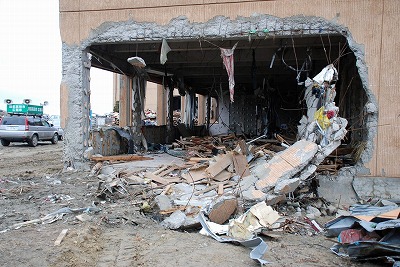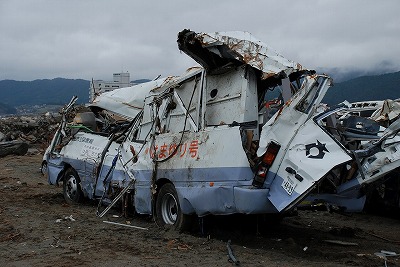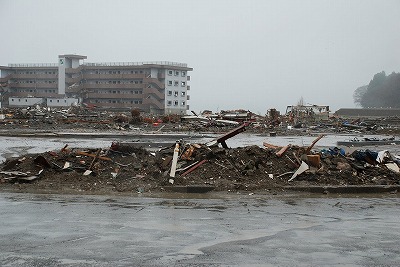The massive 9.0-magnitude earthquake on March 11, 2011 triggered a tsunami that struck the east coast, devastating much of the Tohoku area in Japan. According to the National Police Agency, as of May 14, the confirmed death toll from earthquake and tsunami has risen to almost fifteen thousand people, with more than nine thousand still missing. The earthquake and tsunami left a huge number of displaced people; nearly one hundred sixteen thousand people evacuated to public facilities. The national government announced a plan to build temporary housing for them and started construction. In addition, the earthquake and resulting tsunami also caused severe accidents at the Fukushima Daiichi nuclear power plants, which subsequently suffered explosions and probable nuclear fuel damage. Workers continue to labor to stop the spread of radioactive substances and bring the nuclear plants back under control.
It is obvious that many libraries in eastern Japan are affected by this catastrophe; however, the extent of the damage has yet to be determined. The Japan Library Association (JLA) conducted an investigation of the damage to library buildings, book shelves, and collections, and tallied the casualties among library staff. As of the middle of April, 70 public libraries out of 355 located in Iwate, Miyagi, Fukushima, Ibaragi, and Chiba prefectures are now closed. Nevertheless, each library is struggling to provide services to the people in the community. See the current information gathered by each prefectural library on the following web-site. [http://www.jla.or.jp/index-e.html]
Library situations found by the JLA field research team during March 21-24 are as follows:
<Iwate prefecture>
Rikuzen-Takata City Library: The city suffered catastrophic damage from the tsunami. Most of the city area is covered with piles of rubble. All library staff members were killed or are still missing. The framework of library building remains, but nothing is left inside. A book mobile was also destroyed.
 |
 |
| Rikuzen-Takata City Library: flood power destroyed even wall of reinforced concrete |
Rikuzen-Takata City Library: a bookmobile badly damaged by the tsunami |
Oo-Funato City Library: The library was not damaged, so it has become a shelter. The library staff now takes care of evacuees.
<Miyagi prefecture>
Kesennuma City Library: There was a bulletin board for information relating to the Great East Japan Earthquake at the entrance of the library. It included information on financing, transportation, lifeline systems, education, medical services, lists of people who died, and announcements from the Kesennuma city government. The 2nd floor was not usable and the library has had difficulty receiving new periodicals. The children's room was too damaged to use. Therefore, another children's space was set up in a corner near the regular stacks. The staff themselves survived, and they were trying one way or another to provide information services.Kesennuma City Motoyoshi Library: As this library suffered only minor damage, it now functions as a shelter.
Minami-Sanriku Town Library: The library disappeared without a trace. The chief librarian was killed.
 |
Minami-Sanriku Town Library:
the library disappeared without a trace |
Ishinomaki City Library: It is now a shelter and a place where people can utilize bathing facilities provided by the Self-Defense Forces. Since it is located on a hill, there was no damage from the tsunami. However, many materials were knocked down from the bookshelves by the quake. One of the temporary staff is still missing.
Higashi-Matsushima City Library: Most of the library materials were knocked down onto the floor. The library staff put them back on the shelves; but the materials were knocked down again by the after-quake. The staff members are worried about whether books borrowed from the library were swept away or damaged by tsunami. There are many cases packed with books at the library entrance. They were supposed to have been delivered to elementary schools in the city; but now there is no place to send them because the tsunami also devastated the local schools.
Natori City Library: The library, built in the 1960s, suffered considerable damage. Most of the books fell down onto the floor, old steel shelves leaned over to one side, and some walls fell down.
Sendai Mediatheque: The 7th floor with a theater hall was considerably damaged. Its ceiling fell down onto the floor, etc. In the library, most of the books fell down from the shelves, some windows were broken, and the triple-tier long locker was overturned.
Sendai City Izumi Library: The building's concrete, outer walls, windows, etc. were broken. It would take long time to return to the normal condition. Most of the books fell down, and the staff put them back on the shelves. However, the books fell down again due to the aftershock on April 7.
Miyagi Prefectural Library: Most of the materials fell down onto the floor. The facility itself suffered only minor damage.
The Japan Library Association initiated a program called "Help-Toshokan" in order to support the libraries affected by the disaster. "Help-Toshokan" volunteers visited several kindergartens, shelters at middle schools, and libraries in Kesennuma city on April 22 and 23. They delivered approximately 3,000 picture books to children, performed book reading, storytelling, and "panel theater," in which a story is told through pictures and letters placed on a cloth-covered panel. The storytelling, fingerplay, and panel theater were done in the space at the gymnasium where survivors were staying.
The Japan Library Association will continue to assist the affected libraries through "Help-Toshokan" and periodically examine the situation of those damaged libraries. However, these activities are supported by volunteers. Therefore, the Japan Library Association made the following requests to the Japanese Government: survey the damage at the libraries, make the survey results open to the public, help make a reconstruction plan, aid libraries to rebuild and resume regular services, and provide tools for people with special needs.